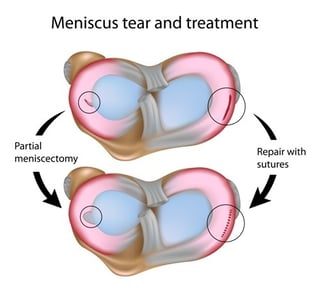Topics:
Search for topics or resources
Enter your search below and hit enter or click the search icon.
June 30th, 2016 | 3 min. read


A meniscus tear is damage sustained to the rubbery, disc-shaped "shock absorber" cartilage inside the knee joint. Such injuries are extremely common in people over age 30, especially athletes who play contact sports.
Most of the time, when someone refers to having torn knee cartilage, he or she is referring to a meniscus tear.
The meniscus is a c-shaped piece of cartilage that functions as padding between the bones of the knee. Each knee has two menisci — a medial meniscus (in the inner side of the knee) and a lateral meniscus (in the outer side of the knee).
The main purpose of the two menisci is to absorb pressure and distribute your body weight through the knees. Menisci also function as another layer of protection for your leg bones, protecting them from osteoarthritis.
Because the knees absorb so much impact from walking, running, and playing sports, the menisci absorb a great deal of impact pressure throughout the day.
Over time and with age, the cartilage naturally begins to wear away from friction, making it more prone to injury. Although anyone at any age can suffer a meniscus tear, people over age 30 are more at risk due to this age-related degeneration.

Meniscus tears tend to be caused by sudden twisting motions, especially when playing sports.
For example, you might tear your meniscus dodging someone on the basketball court or sliding into a base during a baseball or softball game.
However, people also tear their menisci doing everyday activities:
You're most at risk if you meet any of the following criteria.
Being obese also puts added strain on the knee joints, which can contribute to cartilage degeneration at an earlier age.
How will you know if you've torn your meniscus? Symptoms may include:
Keep in mind, many meniscus tears are small and may not present as acute injuries. You may still be able to walk on your knee and participate in activities. Instead of being temporarily disabled, you may find that you notice your knee behaving differently over time.
Subtler symptoms of a meniscus tear may appear from time to time. For example, you may experience the following symptoms occasionally:

Meniscus tears are categorized by orthopedists based on how they look and where they occur within the meniscus.
How well a meniscus tear heals depends in part on where it occurs. Tears in the blood-rich "red zone" at the outer edge of the meniscus can sometimes heal on their own without medical intervention. Tears along the inner portion, in the "white zone," do not receive as many nutrients and therefore may require immobilization or surgery.

In some cases, you can treat the pain and discomfort of a meniscus tear with RICE therapy (rest, ice, compression, and elevation) or NICE therapy (non-steroidal anti-inflammatory drugs, like ibuprofen or naproxen), ice, compression, and elevation).
However, if you suspect you've injured your meniscus, see an orthopedist.
Many meniscus injuries occur in the inner two-thirds of the meniscus, in the "white" zone where blood supply is not as rich. Without nutrients, these injuries seldom heal on their own.
Left untreated, a damaged meniscus can lead to other problems in your knee. Loose meniscus cartilage may move around inside your joint, leading to locking or popping of the knee and knee instability. A chronically injured meniscus can also lead to arthritis.
After evaluating you, an orthopedist may recommend arthroscopic meniscus repair, meniscectomy (full or partial), or, in the case of severe damage, a total knee replacement surgery.
If you think you have a torn meniscus, give Coastal Orthopedics located in Corpus Christi, TX a call. Our orthopedic specialists can examine you, assess your condition, and discuss whether surgical meniscus repair may be an option for you. Telephone: 361.994.1166.
Article written by: Rob Williams, MD
Dr. Williams has been practicing orthopedic surgery in Corpus Christi since 1998. After graduating from Texas Tech hereceived his medical degree from the University of Texas at San Antonio. At the prestigious Campbell Clinic located at the University of Tennessee, Dr. Williams completed not only an Orthopedic Surgery Residency, but an additional year of Fellowship Training in Spine Surgery. Dr. Williams is dedicated to creating an excellent patient experience in the office or in the surgery suite.
Topics: